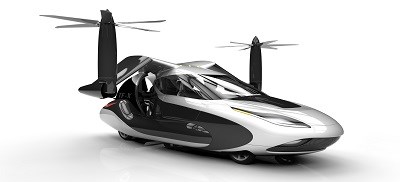A personal flying car for all?
Terrafugia is working on the TF-X, a vertical takeoff and landing (VTOL) version of its flying car, and is building sub-scale flying models. Composites have been used significantly in past Terrafugia models and figures to get prominent use in the TF-X as well.

The Terrafugia TF-X
Terrafugia (Woburn, MA, US), the company that has been developing a flying car for years, is giving a glimpse into their latest efforts via a video that arrived this morning. The trademarked TF-X, Terrafugia's vision for the future of personal transportation, is a four-seat, hybrid electric, semi-autonomous, vertical takeoff and landing (VTOL) flying car. As the TF-X program is currently in the early stages of development, extensive sub-scale flight testing of small versions of the TF-X are required, along with wind tunnel testing and aerodynamic simulation, to refine the vehicle's design.
The company announced on December 1 that the U.S. Federal Aviation Administration (FAA) has authorized Terrafugia to operate small Unmanned Aircraft Systems (sUAS) in the TF-X configuration for research and development (R&D) purposes. Specifically, the FAA exemption will allow Terrafugia to test the hovering capabilities of a one-tenth scale TF-X vehicle and gather flight characteristics data that will drive future design choices. Because of the unconventional configuration of the TF-X, it is vital to achieve sustained, stabilized hovering with smaller models before developing a full-size TF-X prototype. Testing of the sUAS vehicles will be conducted by Terrafugia's experienced flight test team in partnership and communication with all relevant authorities.
An FAA exemption was necessary in order to conduct commercial R&D work with an sUAS, and allows Terrafugia to operate the TF-X scale prototypes in compliance with all airspace and other applicable regulations, up to an altitude of 400 feet and at speeds under 100 mph.
Today, Terrafugia engineers are building the TF-X sUAS and preparing the detailed test plans that will be used for their operation. Watch this amazing video to see how the TF-X will operate. It will certainly be interesting to see how this concept develops!
Related Content
-
Plant tour: Joby Aviation, Marina, Calif., U.S.
As the advanced air mobility market begins to take shape, market leader Joby Aviation works to industrialize composites manufacturing for its first-generation, composites-intensive, all-electric air taxi.
-
Next-generation airship design enabled by modern composites
LTA Research’s proof-of-concept Pathfinder 1 modernizes a fully rigid airship design with a largely carbon fiber composite frame. R&D has already begun on higher volume, more automated manufacturing for the future.
-
PEEK vs. PEKK vs. PAEK and continuous compression molding
Suppliers of thermoplastics and carbon fiber chime in regarding PEEK vs. PEKK, and now PAEK, as well as in-situ consolidation — the supply chain for thermoplastic tape composites continues to evolve.
















